Mad Hedge Biotech and Healthcare Letter
March 5, 2024
Fiat Lux
Featured Trade:
(THE SKINNY ON ECONOMIC GROWTH)
(LLY), (NVO), (AMGN)
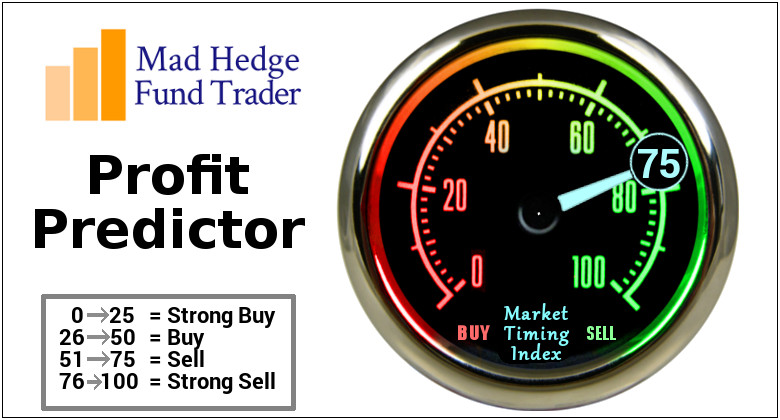
Mad Hedge Biotech and Healthcare Letter
March 5, 2024
Fiat Lux
Featured Trade:
(THE SKINNY ON ECONOMIC GROWTH)
(LLY), (NVO), (AMGN)

What might just give economies a bigger jolt than the frenzy of the Super Bowl or a jampacked Taylor Swift world tour? If you guessed the recent buzz around weight-loss drugs, take a bow. You see, it's not just about slimming waistlines anymore – these breakthrough medications could be a game-changer for the whole economy.
But first, a sobering reality check: health issues have been nibbling away at the U.S. labor force like a sneaky termite over the last 30 years, shaving off two to three percentage points.
Then there's the matter of early departures from this mortal coil, chipping away another 0.2 percentage points from annual labor growth.
Not to mention the legion of unsung heroes caring for the ailing, effectively benched from the workforce, leading to a 3% labor force deficit.
Among all the health issues affecting the labor force, obesity has been identified as a sneaky little gremlin, dragging down productivity and participation in the workforce.
With obesity affecting 40% of the U.S. population, we're talking about a hefty 1% slash in total output.
But what if there was a way to combat this? Enter stage left: Eli Lilly (LLY). Sure, you might know them as a big-league player in the pharma world, but did you know they're the brains behind blockbuster medications like Trulicity, Mounjaro, and cancer-battling Verzenio?
And the story gets even more exciting – it's not just their existing all-star lineup that's sent their stock soaring 180% since 2021. Their latest weight-loss marvel, Zepbound, got the FDA's green light last November. Think of it as Mounjaro's twin, sporting the same molecule but with a different name to keep things clear for their existing diabetes patients.
This breakthrough signals a massive shift in the obesity treatment landscape. The global anti-obesity market is projected to explode to a staggering $100 billion annually by 2030 – a dramatic leap from last year's $6 billion. To put that in perspective, global spending on cancer treatments is estimated at $220 billion this year.
Naturally, Lilly is poised to grab a big slice of that pie. Analysts are predicting a healthy 21.4% revenue boost this year, and nearly 24% by 2025. Talk about a growth spurt.
As for earnings? They're looking at nearly tripling in that timeframe. The future's so bright, Lilly might need shades.
But here's the catch: Lilly's stellar rise has its stock priced at a premium, and then some. We're talking 60 times this year's expected earnings. And while the company's profit train is set to chug along, not every stock can keep up those lofty valuations in the long haul.
And let's not forget about the competition. Novo Nordisk (NVO), with its own contenders Ozempic and Wegovy, is nipping at Lilly's heels, even as Amgen (AMGN) and others are hot on the trail with promising candidates of their own.
Yet, Lilly's not sweating it. With Zepbound (aka Mounjaro for the weight-conscious) already making waves as a go-to for obesity treatment, they're sitting pretty. It's like they've already won half the battle, with doctors and patients already in the know about this not-so-secret weapon.
Still, as tempting as it might be to hop on the Lilly bandwagon after seeing those numbers, we need to do a quick reality check before investing. It's important to remember that every stock has its ups and downs.
For starters, Lilly's stellar rise means their stock is trading at a premium – a hefty 60 times this year's expected earnings. And while the company's profit train is definitely chugging along, that kind of lofty valuation might be a bit too spicy for some investors' taste, especially in the long run.
So, what's the takeaway for those who want in on the action? Lilly's current price tag might give you pause, especially if you're looking for a bargain.
It's been a wild ride for this stock, and sometimes the best moves involve waiting for the market to catch its breath.
However, their dominant position in a rapidly expanding market definitely makes them a player worth watching closely. I suggest to buy on the dip.
Switching gears for a second, let’s take a look at the big picture. It turns out that widespread use of GLP-1 medications like Lilly's could deliver way more than just individual weight loss. We're talking about a potential shot in the arm for the entire U.S. economy.
Think about it: if 30 million Americans hop on the GLP-1 train with drugs like Mounjaro and Zepbound, and a conservative 70% of them see benefits, we could see a 0.4% boost in the U.S. GDP. And that's just the starting line.
In a best-case scenario, where 60 million Americans embrace these treatments and a whopping 90% benefit, the GDP could potentially surge by a full 1%. Even with more modest projections, with 15 million users and a 50% success rate, the economic impact would still be noteworthy.
This isn't just pocket change – it's serious economic muscle. With the right push, these weight-loss drugs could be the breakthrough prescription our economy needs, adding some serious pep to our growth alongside countless individual health transformations. Now, isn't that a story worth following?
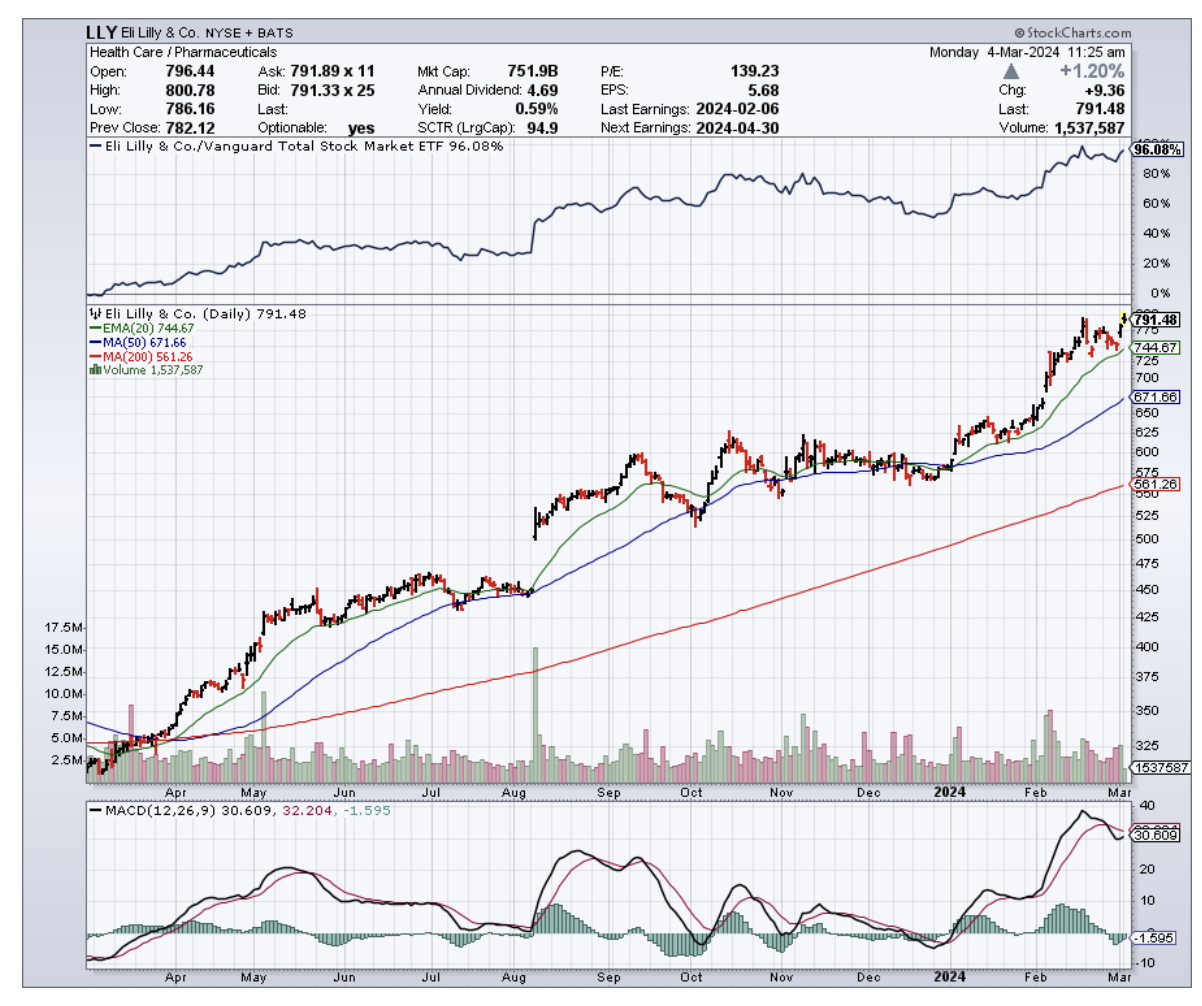

Mad Hedge Biotech and Healthcare Letter
February 6, 2024
Fiat Lux
Featured Trade:
(SETTING THE TABLE FOR STEADY GAINS)
(ABBV), (ABT), (PFE), (GILD), (DNA), (MRNA), (AMGN), (LLY)
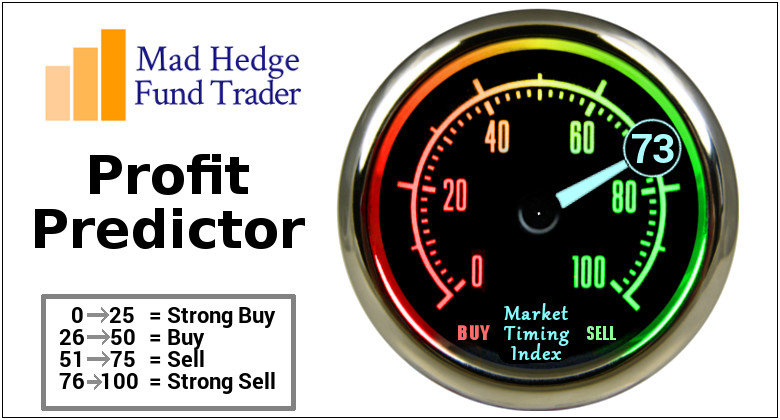
Here's a nugget of wisdom from someone who's sailed the investment waters more times than I've had hot dinners: diversification is your best friend. Think of it as the Swiss Army knife in your investment toolkit.
Now, if there's one treasure you'd want aboard your investment ship, it's a dividend stock. Not just any old stock, though. I'm talking about AbbVie (ABBV).
Since it waved goodbye to its parent company, Abbott Laboratories (ABT), in 2013, it has boosted its dividend payouts by an eye-popping 290%. With a yield hanging around 4% and delivering a 130% total return over the past 5 years, long-term investors undoubtedly struck gold.
Unfortunately, 2023 has turned into the kind of year we'd rather forget. The end of Humira's patent was looming like a dark cloud, threatening to rain on AbbVie's parade by letting generics flood the market. The horror, right?
But, plot twist: the anticipated disaster was more of a light drizzle. Despite the competition, Humira still brought in a cool $11.1 billion. Sure, it's a dip, but not the plunge we feared.
Meanwhile, AbbVie's been on a shopping spree, snapping up Immunogen and Cerevel for a combined total that's a smidgen under $19 billion. It's like they're collecting Infinity Stones, diversifying beyond Humira into areas ripe with potential.
And let's not forget their foray into the realm of Antibody Drug Conjugates (ADCs) — the hot ticket in oncology.
While AbbVie’s not throwing around cash like confetti, like some of their peers including Pfizer (PFE), Gilead Sciences (GILD), Genentech (DNA), they're making notable moves. It's a bit like betting on the dark horse; if their ADCs and CNS ventures hit their stride, we're all in for a treat.
Amidst all this innovation and expansion, AbbVie hasn't lost sight of what gets investors' hearts racing — a solid dividend. It's the kind of steady reliability that's as comforting as your favorite cozy blanket.
As if those aren’t enough, the company just threw us a curveball that's got Wall Street buzzing more than my neighbor's annoying leaf blower on a peaceful Sunday morning.
In its recent earnings report, AbbVie not only beat the revenue expectations for its fiscal fourth quarter but decided to sweeten the deal by raising its long-term sales outlook.
Despite the concerns about Humira, AbbVie still posted fourth-quarter earnings that had their investors nodding in approval, even if they were a tad lower than previous years’ glory days. With revenue hitting $14.3 billion, surpassing the street's guess of $14 billion, it's clear the company isn't just hanging in there; it's throwing punches back.
The immunology portfolio, while taking a 12% hit, isn't down for the count, thanks to Skyrizi and Rinvoq. These two rising stars, which are quickly becoming the Batman and Robin of the biopharmaceutical world, are not just filling Humira's big shoes; they're sprinting.
With the duo’s sales surging by 52% and 63%, respectively, it's no wonder AbbVie is adjusting its binoculars and raising its long-term guidance for these drugs to a whopping more than $27 billion by 2027.
That's a $6 billion jump from their previous forecast. If that doesn't scream confidence, I don't know what does.
And just for a bit of perspective, while AbbVie was basking in the glow of success, its peers had a mixed day at the market. Pfizer took a slight tumble, Moderna (MRNA) and Amgen (AMGN) dipped their toes into the red, while Eli Lilly (LLY) floated up, riding a wave of optimism.
So, as we move forward this 2024, you might be wondering, "What's next for AbbVie?"
Well, if I were a betting man (and let's be honest, investing is betting with extra steps), I'd say we're not likely to see AbbVie pulling a rabbit out of a hat.
But, and it's a big but, we're talking about a company that's as expertly managed as a Michelin-starred kitchen. They've got a knack for serving up share price growth and dividends that leave investors coming back for seconds.
So while AbbVie might not be dangling the next blockbuster breakthrough in front of us, their steady march forward is as promising as finding a shortcut on your morning commute. We might not see the stock skyrocket overnight, but a climb to around $180 per share? That's not just possible; it's on the menu. And right now, with its recent earnings report, it's as good a time as any to pull up a chair to the AbbVie table. Bon appétit.
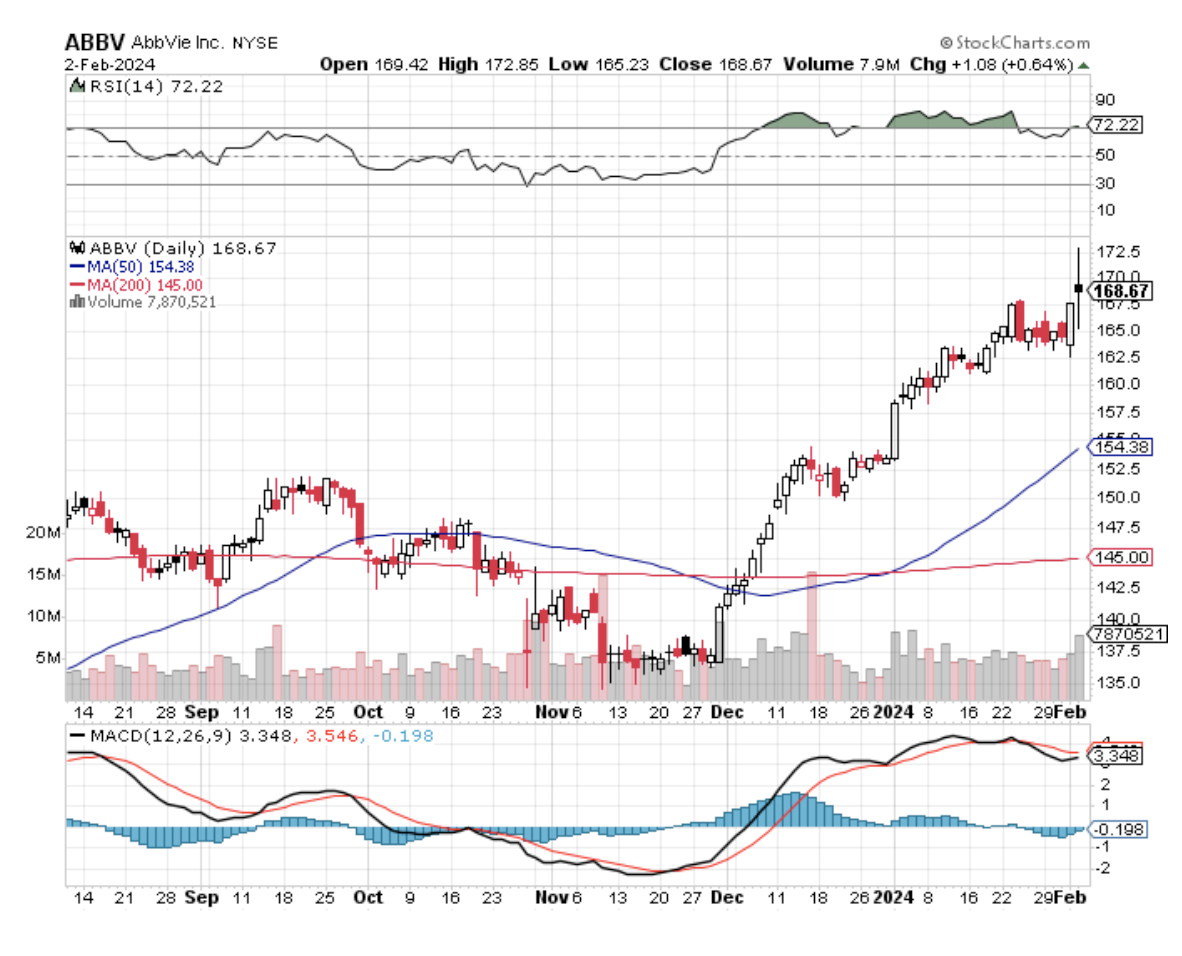
Mad Hedge Biotech and Healthcare Letter
January 30, 2024
Fiat Lux
Featured Trade:
(BRAIN GAINS)
(BIIB), (ESALY) (LLY), (REGN), (ALNY), (MRK), (AMGN), (PFE), (BMY)

Let's talk about a golden opportunity knocking at our doors – the booming market of Alzheimer's disease treatments in biopharma. We're not just talking about a small uptick here. With a slew of new meds on the horizon, this market is gearing up for some serious growth, and you might want to grab a piece of this pie.
The dominant name on our radar is Biogen (BIIB), ticking at $260 per share with a market cap that's flirting with $39 billion.
Now, with a solid $10 billion in sales and trading at a nifty 16 times its 2024 estimated earnings, Biogen's got some serious mojo. I've been eyeing it since last year, but boy, have things changed since then.
A critical game-changer was Chris Viehbacher, the new CEO since November 2022. He's already played a couple of aces – slicing $800 million in costs (which, by the way, could pump up earnings by $5 a share by 2025) and wrapping up the acquisition of Reata Pharmaceuticals in September 2023.
This new addition to Biogen’s portfolio has a hot ticket item, Skyclarys, for treating Friedreich’s ataxia. It's a rare find, but it could add a cool $5 per share in earnings in a few years.
But the most exciting name in Biogen’s arsenal is Leqembi, the company’s Alzheimer’s treatment. They're splitting the pot with Eisai (ESALY), and this drug is a little like turning back the clock on cognitive decline – think a two-year rewind button.
The big bucks talk here: we're eyeballing $2 billion in revenue by 2028 and maybe a whopping $4 billion by 2033. And hey, there might even be more where that came from.
Let's chew on a few things here. Biogen has the potential to snag a 60% market share against Eli Lilly’s (LLY) donanemab – the only worthy opponent in the market so far. And given Leqembi's safety creds, this might be playing it safe.
Aside from Eli Lilly, there’s Roche (RHHBY), with candidates in Phase 2 and Phase 1 trials, but they're not quite hitting the jackpot yet. As for other competitors in the space like Regeneron (REGN) and Alnylam (ALNY)? Well, they're cooking up something different in Phase 1, but it's a bit early to call.
Meanwhile, Biogen's got another trick – a home-use version of Leqembi coming this fall. And get this: doctors are buzzing about nipping Alzheimer’s in the bud, way before it crashes the party. Imagine getting a jab of Leqembi as part of your routine check-up when you're only 50. If this works, then we could be kissing Alzheimer’s goodbye by 2040.
For the longest time, Biogen was like that one-hit wonder with its multiple sclerosis treatments. But now, they're swinging for the fences with the largest unmet health need out there. If Leqembi hits it big, and I mean really big, we could be talking about sales far beyond that $4 billion mark by 2033.
But let's not get ahead of ourselves. The big pharma world is about to hit a few speed bumps with a wave of patent cliffs from 2025 to 2029. That’s a headache for the likes of Merck (MRK), Amgen (AMGN), Pfizer (PFE), and Bristol Myers Squibb (BMY).
Biogen, though, is sitting pretty with two growth products and a pipeline that’s got pizzazz. Plus, they're a hot catch for any big pharma looking for a dance partner without stepping on regulatory toes.
As we roll into the next decade, keep your eyes peeled for investment opportunities popping up like daisies. And don't feel like you've got to jump on the first bandwagon that rolls by. This market's just stretching its legs, and today's champs might just be tomorrow's old news.
So, what's the smart play here? Spread your bets across a few horses in the Alzheimer's race, and make sure they're not one-trick ponies.
Eli Lilly, for instance, is more than just an Alzheimer's bet – they're making waves in diabetes and soon, obesity treatments. Biogen, despite its Alzheimer's experience, is a bit of a gamble, especially after its first drug's rocky start.
Remember, investing in Alzheimer's treatments now is like catching the early wave – it's riskier, sure, but the potential for a big payoff is there. This is an emerging market, and it's revving up for an exciting ride. I suggest you add these names to your watchlist.
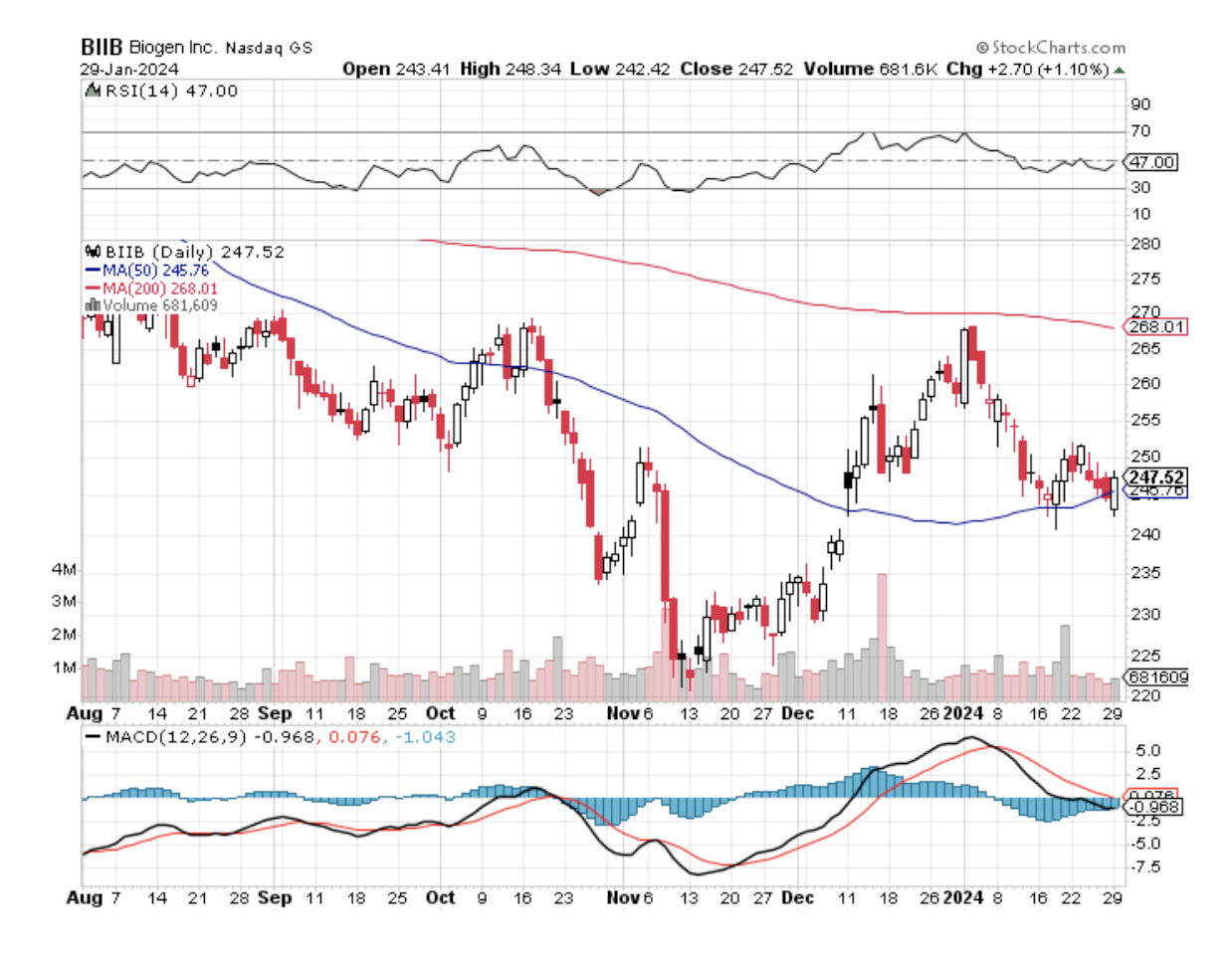
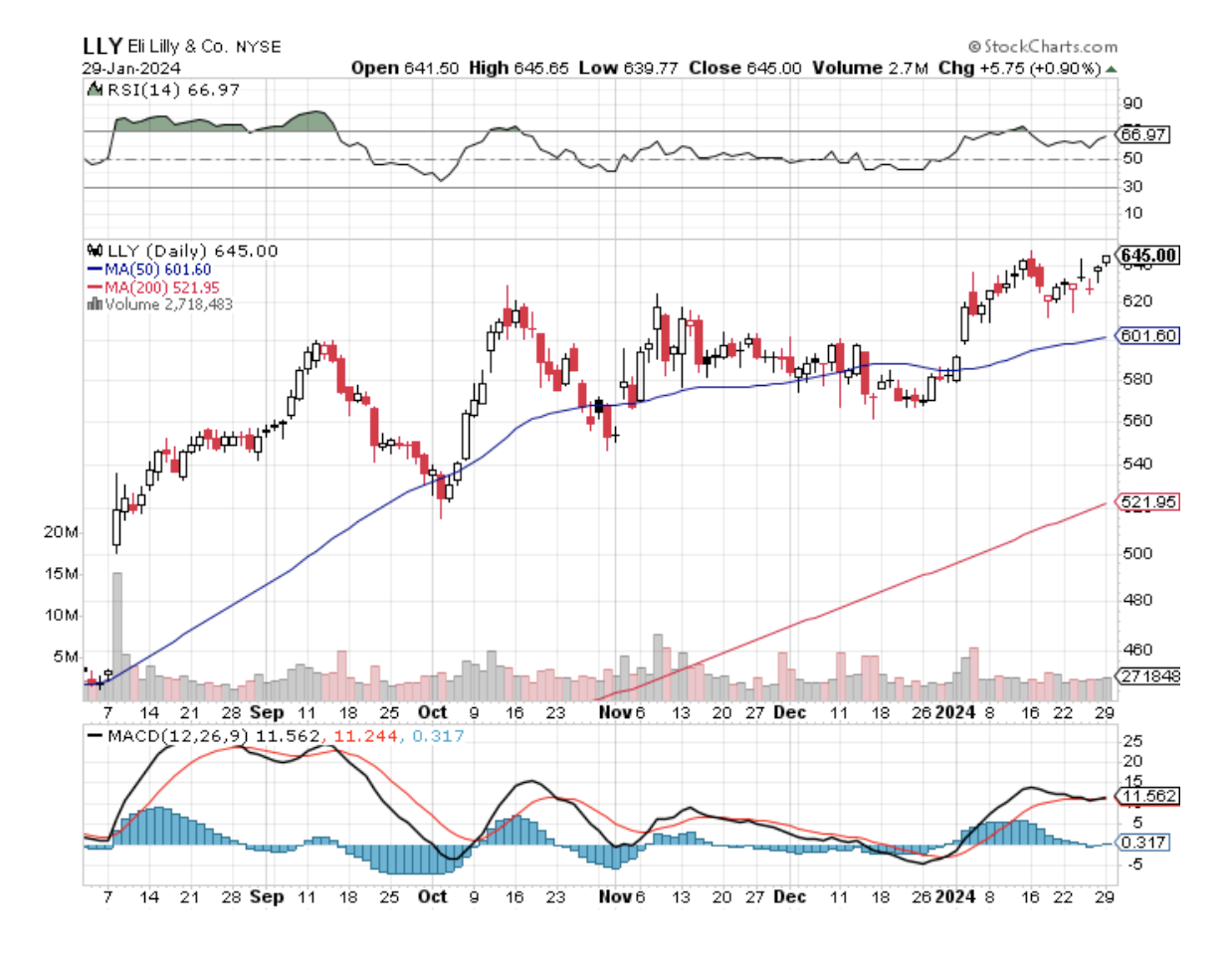
Mad Hedge Biotech and Healthcare Letter
January 2, 2024
Fiat Lux
Featured Trade:
(FROM LIMPING TO LEAPING)
(LLY), (NVO), (PFE), (AMGN), (VRTX), (BMY), (CRSP), (NTLA)

The year 2023 in the biotechnology and healthcare world has been a rollercoaster with more dips than peaks.
While Eli Lilly (LLY) and Novo Nordisk (NVO) are hitting the jackpot with their new weight loss drugs, the rest of the healthcare sector is limping behind.
By year's end, the S&P 500 Health Care index had slipped by 0.4% since the start of the year, starkly contrasting the broader S&P 500's robust 24% growth.
That’s not just a minor setback; it's the sector's most significant underperformance in 30 years.
Fast forward to 2024. Conventional wisdom suggests healthcare stocks might lag in an election year. Why? Presidential candidates love to shake things up with healthcare reform promises, usually sending investors into a sell-off frenzy.
But this time around, the air is tinged with an unexpected optimism. After a year of hefty sell-offs, healthcare valuations have become irresistibly low, presenting a fertile ground for investment opportunities.
Plus, there's less regulatory uncertainty now, with major acquisitions like Amgen's (AMGN) of Horizon Therapeutics and Pfizer's (PFE) of Seagen sailing through without a hitch. And let's not forget the anticipated interest rate cuts could be a game-changer for the sector.
Interestingly, the typical election-year healthcare jitters might be less intense in 2024. After all, the likely presidential candidates are familiar faces, and the healthcare changes they've made (or not made) are well known.
Trump’s healthcare impact was minimal, and Biden has already pushed through significant drug pricing reform with the Medicare drug price negotiation program. This program, despite legal hurdles, is moving forward and has been priced into the market's expectations.
In a surprising turn of events, the Biden administration's recent move to potentially invalidate patents of some high-priced drugs didn't send investors running for the hills like it might have in previous years. It seems the fear of drug price regulation may be losing its sting.
Now, let's take a closer look at some of the healthcare sectors that are drawing attention.
Biotech has been in a slump since 2020, but things are starting to look up. The sector's last three-year downturn was in 1992, followed by a significant rebound.
Despite challenges like high capital-raising costs and a deluge of IPOs, biotech is showing signs of life. As these pandemic-era companies mature and produce valuable data, they offer both buying and selling opportunities.
M&A activity in biotech is also on the rise, and if interest rates fall, the sector's prospects look even brighter.
Keep an eye on Vertex Pharmaceuticals (VRTX), which is set to reveal more data on its experimental pain drug, and Amgen, which is awaiting data on its new obesity pill. CRISPR Therapeutics (CRSP) and Intellia Therapeutics (NTLA) should be on your watchlist, too.
Over in MedTech, the hype around GLP-1 weight loss drugs led to a sector-wide selloff.
The iShares Medical Devices ETF took a hit, dropping 13.9% by the end of October, but it started to recover in the last two months of the year. The GLP-1 concerns might continue to cast a shadow, but there's a growing sense that their impact might be more long-term, especially if interest rates fall.
In the pharma world, 2023 was a tale of two halves: Eli Lilly and Novo Nordisk on one side, with their successful weight-loss drugs and the rest trailing behind.
While the S&P 500 Pharmaceuticals index slightly declined, Lilly and Novo surged ahead with 56% and over 45% gains, respectively.
But 2024 might bring new challenges, especially for Lilly, as it rolls out Zepbound, its highly anticipated weight-loss drug.
For Novo, the focus will be on how Ozempic fares under Medicare's new drug pricing negotiations set to take effect in 2027.
The key to success in pharma now is finding companies with innovative drugs that promise revenue acceleration without the looming threat of patent cliffs. Pfizer and Bristol Myers Squibb (BMY), for instance, are under the microscope as they navigate impending patent expirations and strive to reassure investors.
In 2023, the healthcare market was a stock picker's paradise, especially given its complexity. The year ahead promises more of the same. Investors should be on the lookout for opportunities among stocks that underperformed last year but have solid fundamentals.
Despite the unpredictability of election years and the bumpy ride of 2023, the healthcare sector, buoyed by low valuations and potential rate cuts, is gearing up for what could be a significant turnaround this 2024. For savvy investors, this could be an opportunity not to be missed.
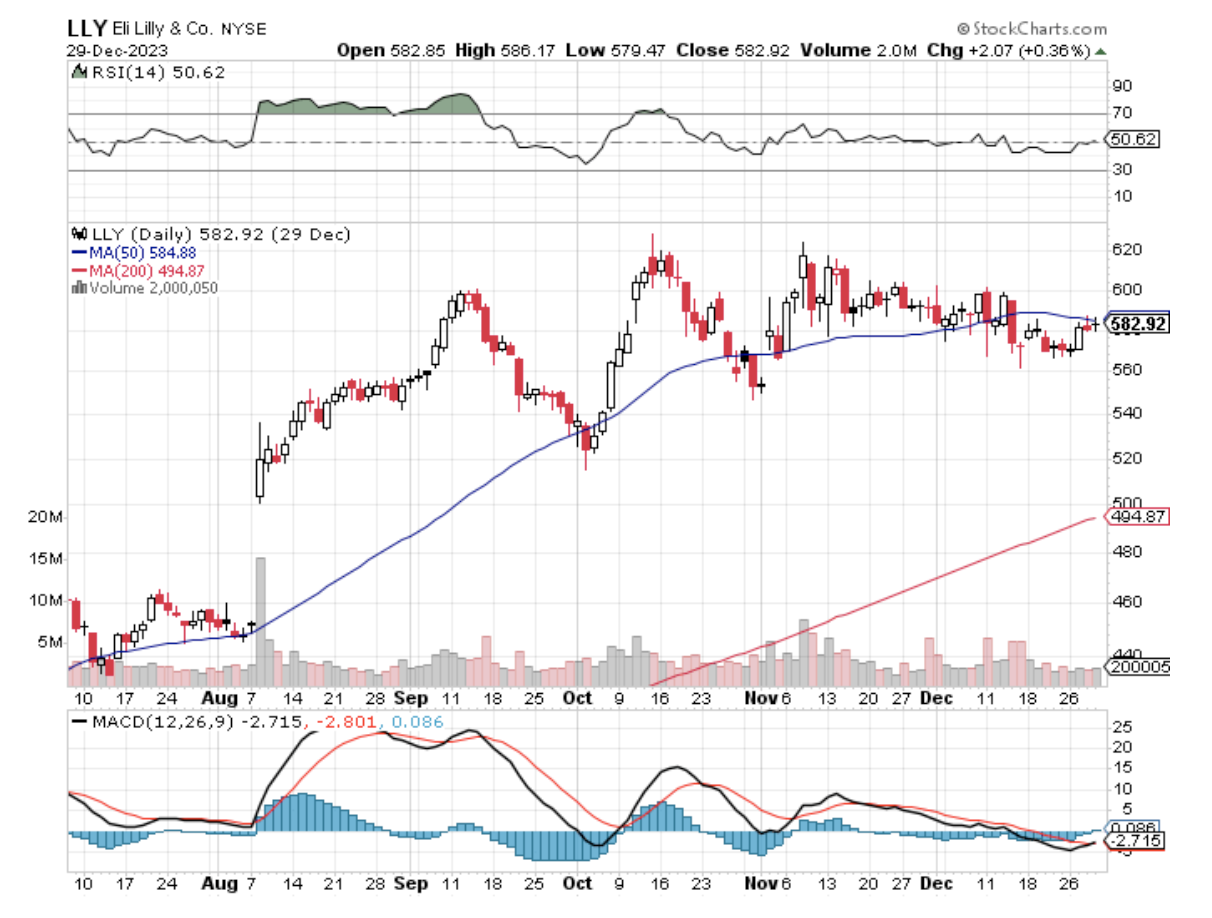
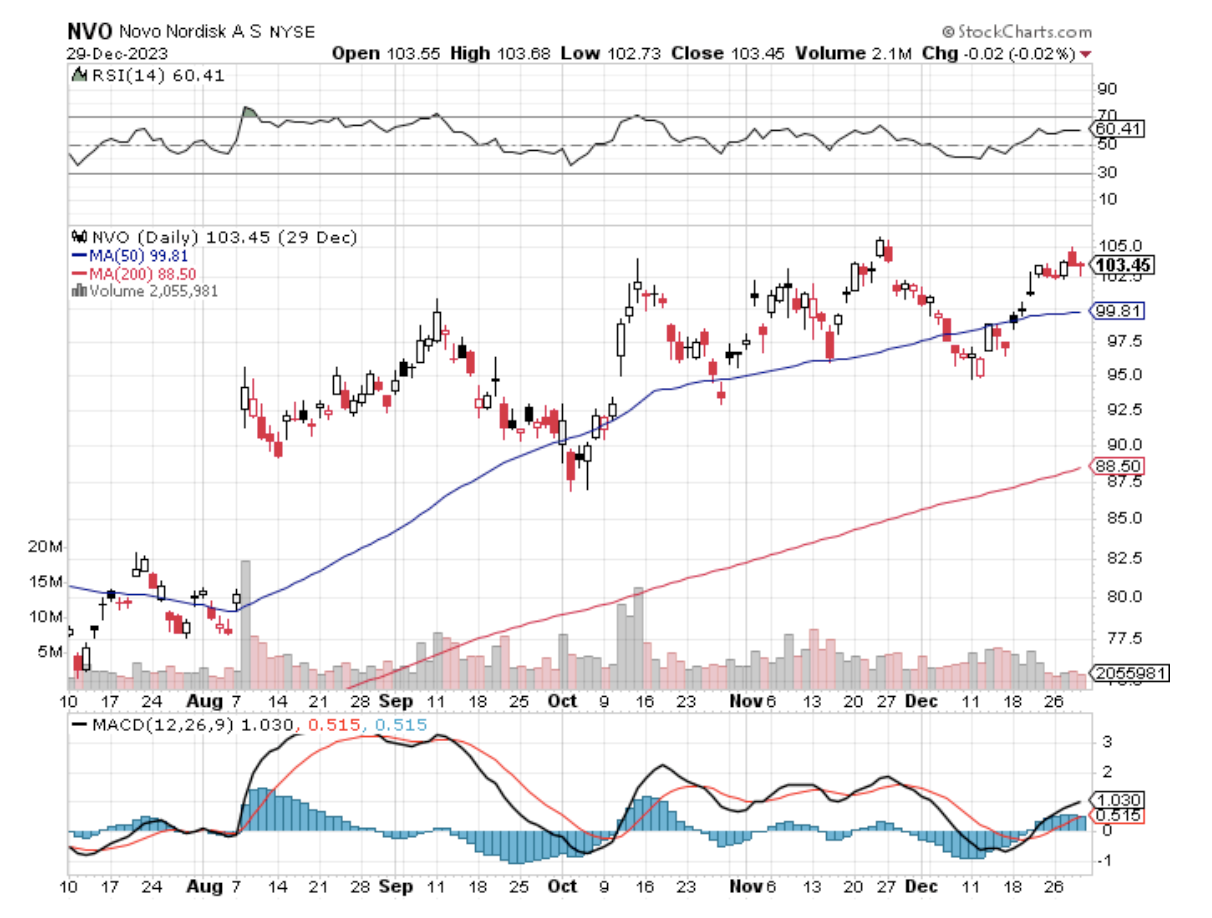
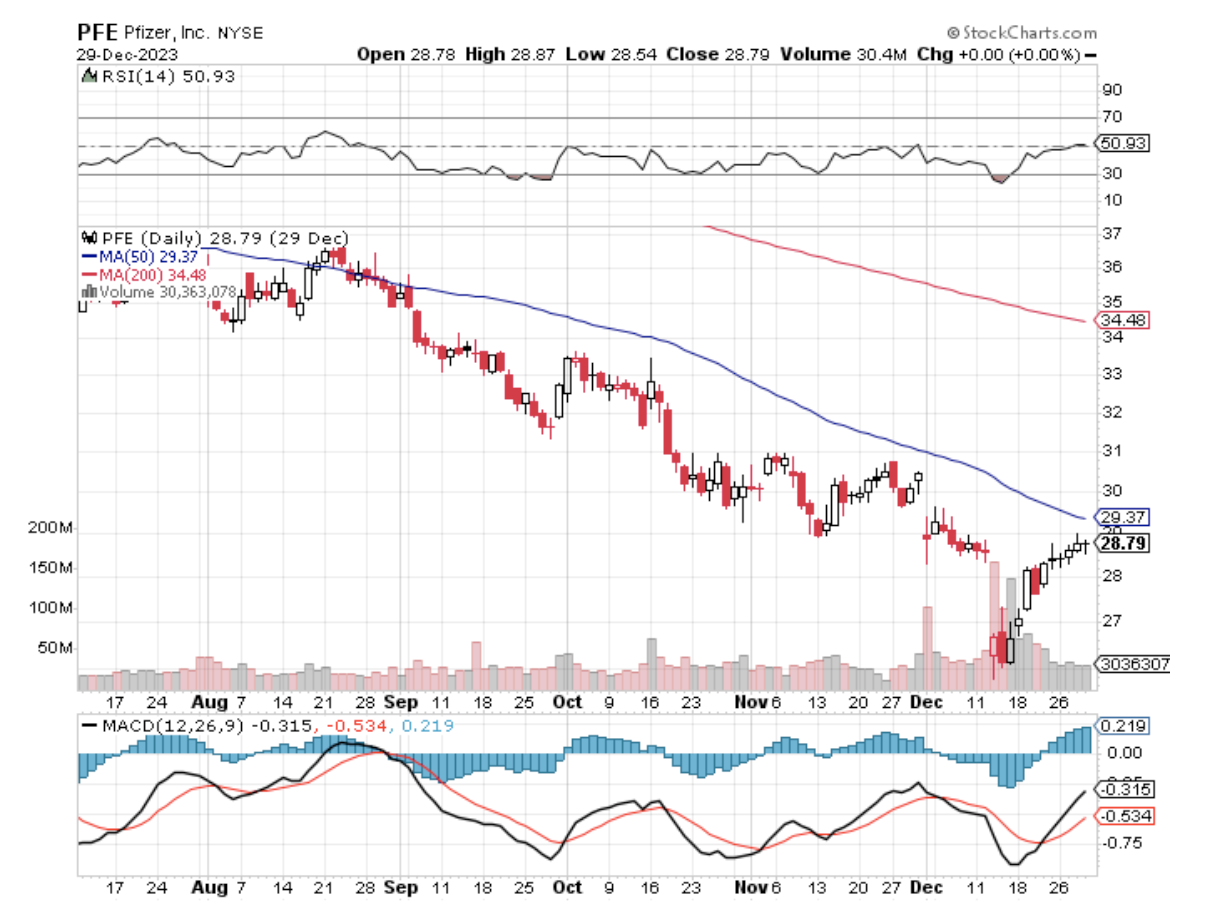
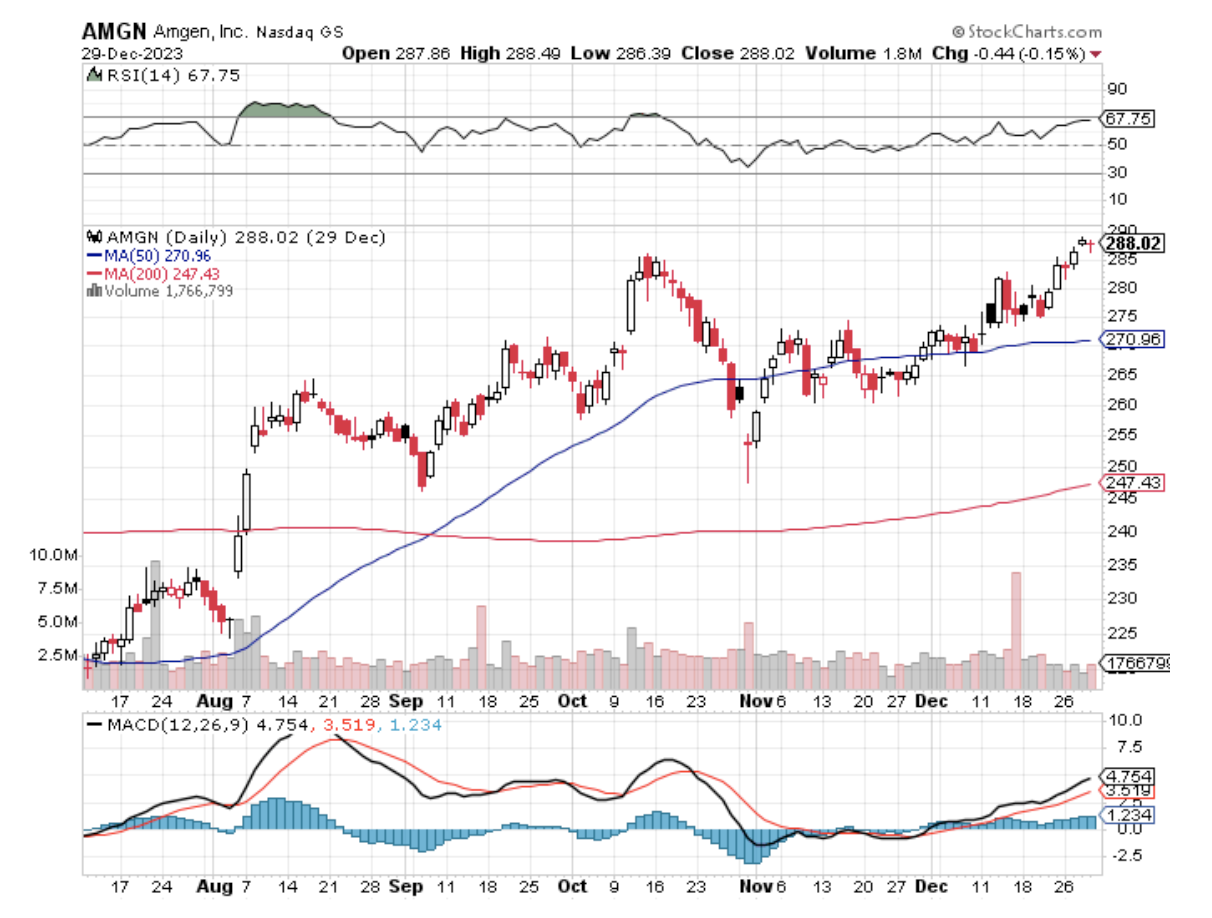
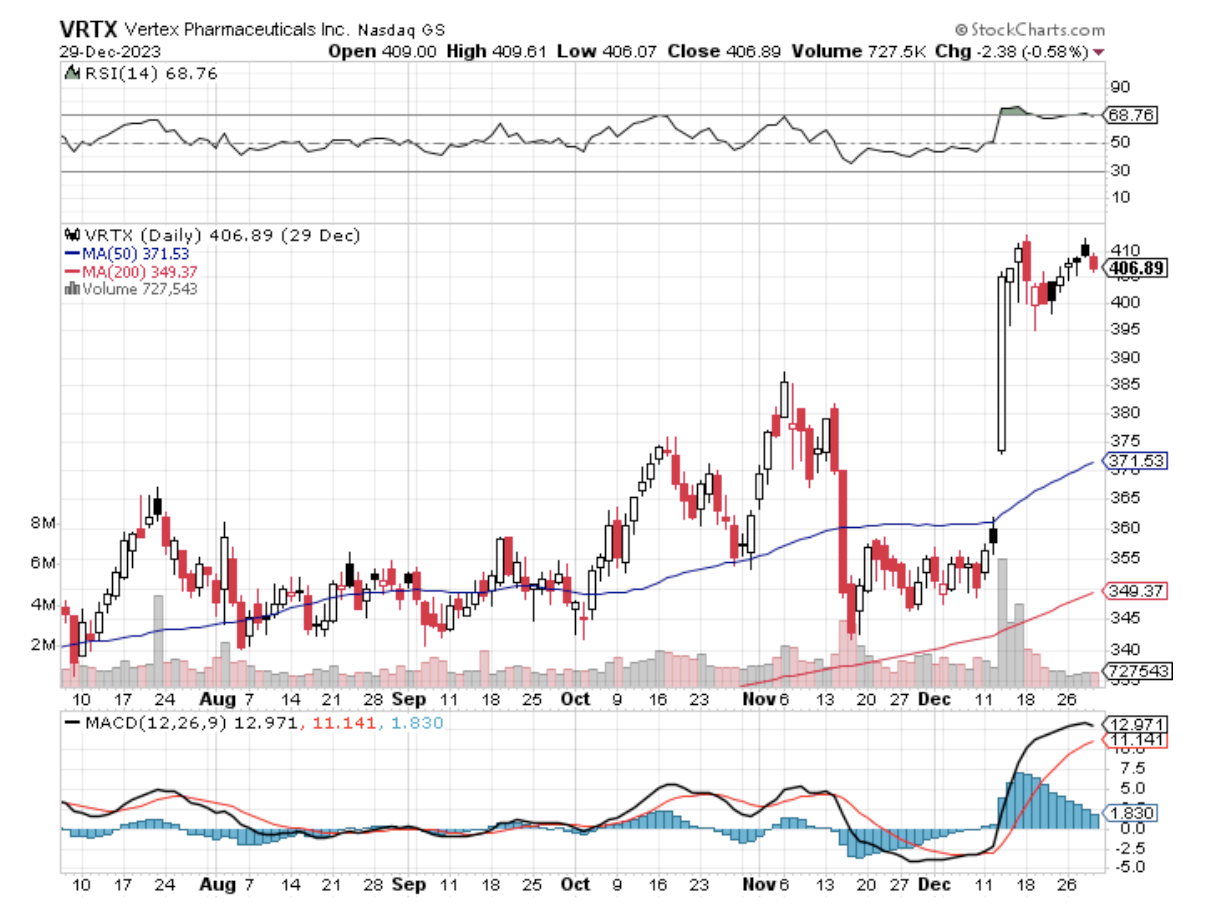
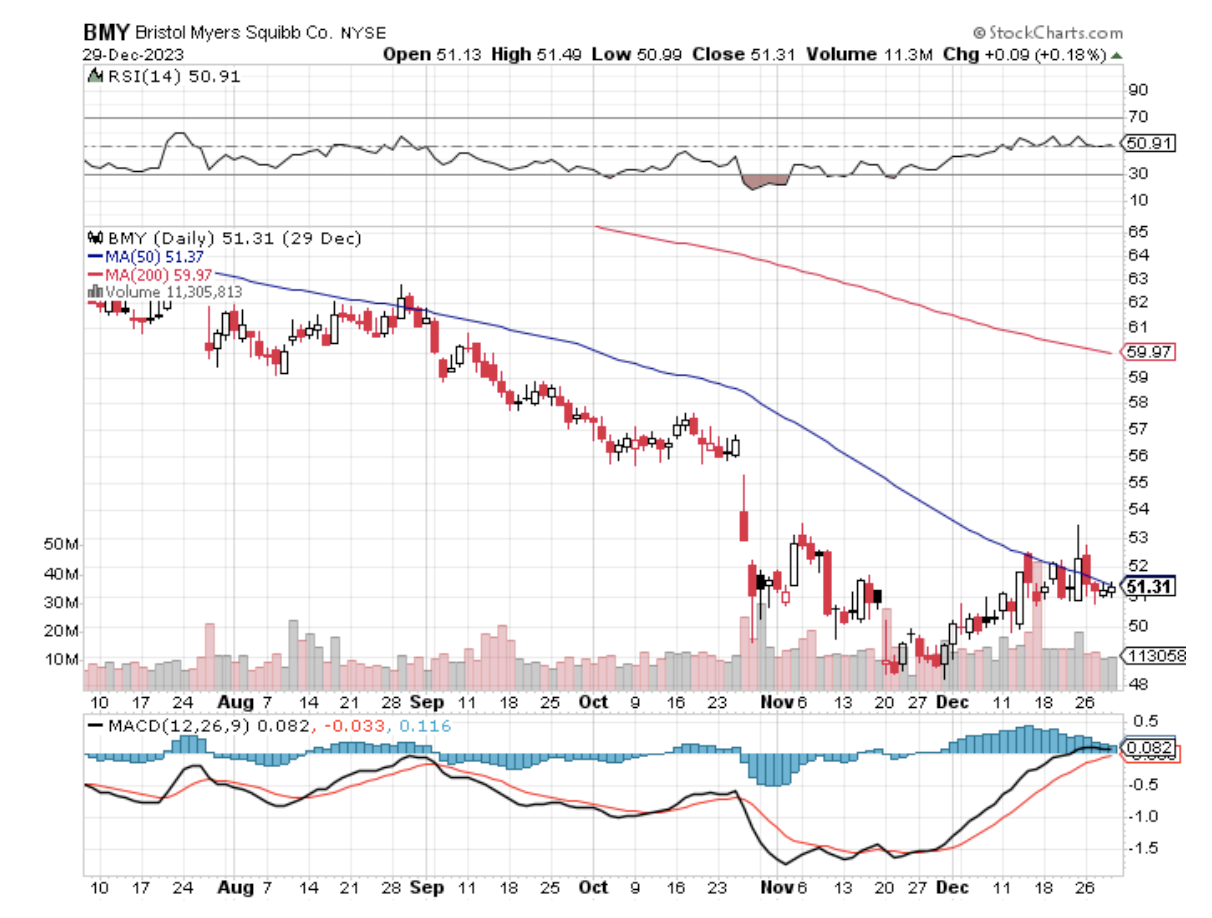
Mad Hedge Biotech and Healthcare Letter
December 28, 2023
Fiat Lux
Featured Trade:
(CLOSING THE YEAR WITH A BANG)
(XBI), (ABBV), (IMGN), (RHHBY), (PFE), (MRK), (AMGN), (VKTX), (TERN)
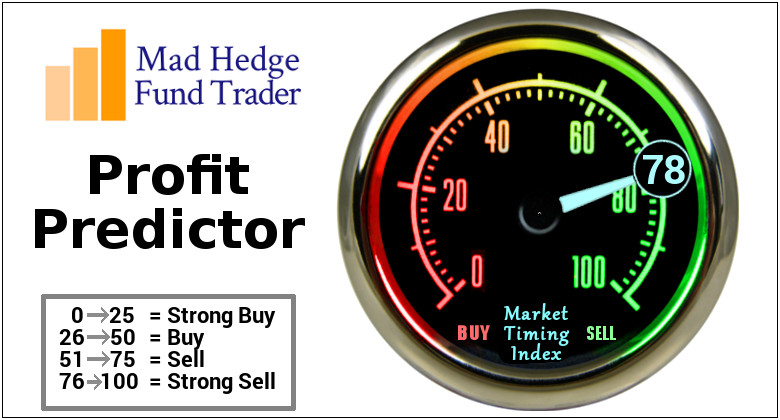
The biotechnology sector, pretty much like a phoenix rising from the ashes of its recent lackluster performance, is experiencing a renaissance as 2023 draws to a close. The recent spree of high-stakes deals has set the stage for what could be a significant rebound, a situation that savvy investors should watch closely.
In a remarkable display of strategic maneuvering, AbbVie (ABBV) has been on an acquisition tear.
Earlier in December, they've recently snapped up Cerevel Therapeutics for an eye-popping $8.7 billion, only a week after announcing their intent to acquire ImmunoGen (IMGN) for a formidable $10.1 billion.
And in this high-stakes game, Roche Holding (RHHBY) isn't playing second fiddle, having declared their acquisition of Carmot Therapeutics for $2.7 billion.
This flurry of activity isn't just a few isolated incidents. It's actually a trend. Of the 18 biotech acquisitions exceeding $1 billion announced this year, a significant one-third have emerged since October. This surge is like a shot in the arm for the sector, suggesting a much-anticipated uptick.
But let's take a step back and consider the broader picture.
The SPDR S&P Biotech ETF (XBI) has shown some muscle in November and December. However, it's still trailing behind this year, down by 3%, while the S&P 500 has surged by 19.5%.
Now, focusing on the XBI, a temperature check for the sector: trading around $80, it's a steep drop from its heyday in the $140 range during late 2020 and early 2021. It's down nearly 50% from its peak in February 2021.
This isn't just a dip; it's a nosedive.
Looking at the turn of events, it’s possible that the AbbVie-ImmunoGen deal is perhaps the precursor to a more consistent pattern of mergers and acquisitions in 2024. It seems that we've hit the floor and the only way now is up, with M&A activities poised to inject some much-needed vitality into the sector.
In previous years, the biotech valuations took a hit, and understandably, companies were hesitant to settle for offers that undervalued them compared to their pandemic-era zeniths. But this year, the tide has turned.
Notably, the cumulative value of biopharma deals at a whopping $128 billion this year, shooting up from $61 billion in 2022.
Key transactions fueling this jump include Pfizer's (PFE) massive $43 billion deal for Seagen and Merck’s (MRK) $10.8 billion acquisition of Prometheus Biosciences.
The shift in the regulatory landscape is also worth noting.
Antitrust regulators, who initially seemed poised to block deals like Amgen's (AMGN) $27.8 billion acquisition of Horizon Therapeutics, have shown more flexibility. This change in stance is likely emboldening companies to pursue larger deals.
Now, let's talk about the financial clout.
Large-cap biopharma companies are projected to have about $199 billion in cash by year-end. There's a noticeable dip in dividends and stock buybacks, hinting at a strategic pivot towards mergers and acquisitions. It could indicate that we can expect Pharma to maintain an aggressive stance on the M&A front.
So, what's in store for the XBI and investors alike?
This uptick in M&A activity is like untying the strings of a tightly held purse, releasing cash back into the sector. It's a magnet for both specialist and generalist investor interest, a potential boon for the XBI.
Predicting the next wave of M&A is basically like reading tea leaves. Yet, this year has shown a marked preference for biotechs specializing in obesity, immunology, and cancer.
A notable example is the speculation around Pfizer eyeing a deal with a biotech firm developing an anti-obesity pill.
The ripple effect? Shares of Viking Therapeutics (VKTX) and Terns Pharmaceuticals (TERN), both in the obesity pill race, have seen their stocks jump 47% and 62.5%, respectively, in December.
Evidently, the biotech sector, once in the doldrums, is now witnessing a renaissance. This resurgence is marked by major deals reshaping the industry landscape, holding significant implications for 2024 and beyond.
For investors, this sector represents a fertile ground for growth and opportunity. Staying informed and nimble is key to capitalizing on these dynamic developments. The biotech sector, it seems, is back in the game, and how!
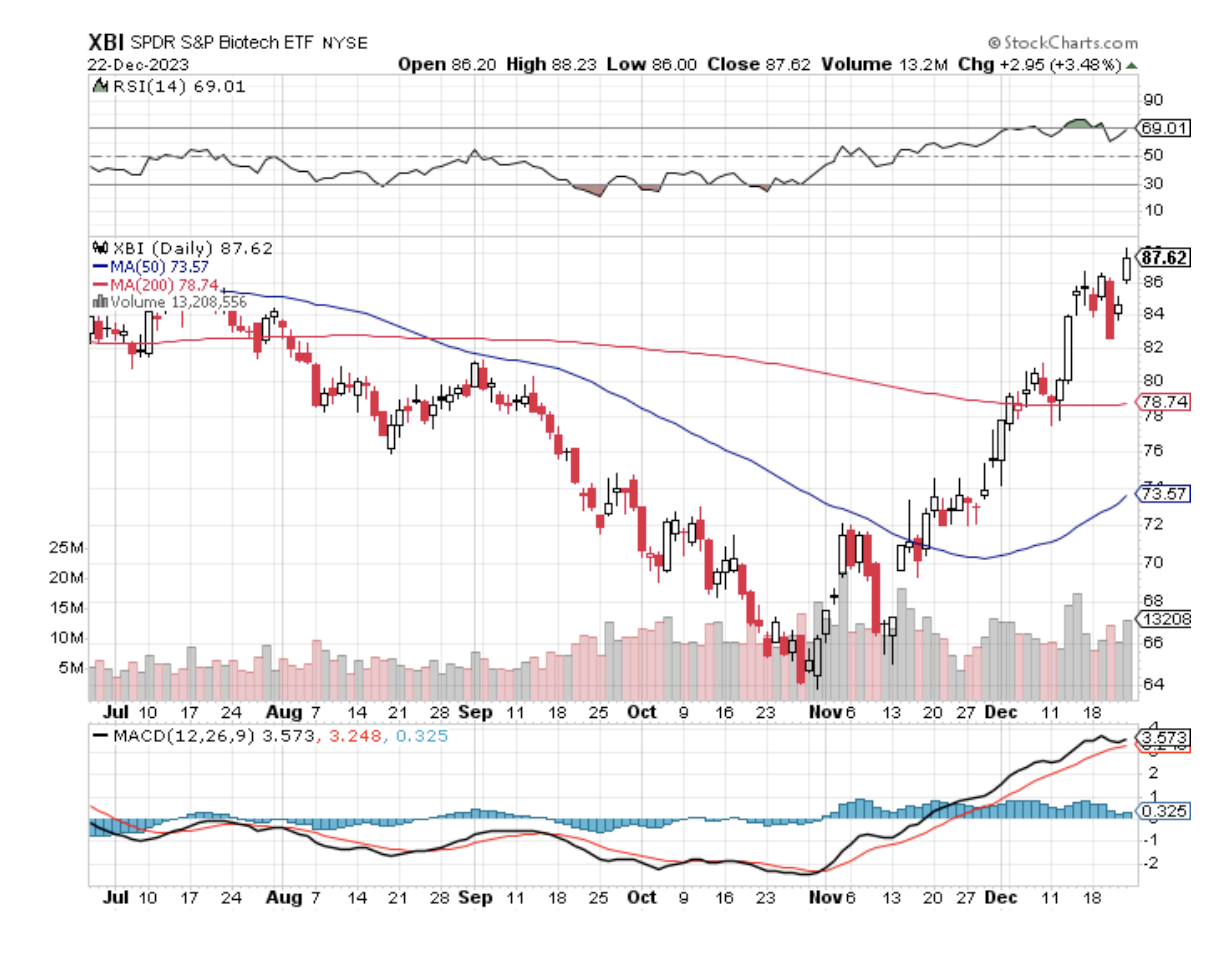
Legal Disclaimer
There is a very high degree of risk involved in trading. Past results are not indicative of future returns. MadHedgeFundTrader.com and all individuals affiliated with this site assume no responsibilities for your trading and investment results. The indicators, strategies, columns, articles and all other features are for educational purposes only and should not be construed as investment advice. Information for futures trading observations are obtained from sources believed to be reliable, but we do not warrant its completeness or accuracy, or warrant any results from the use of the information. Your use of the trading observations is entirely at your own risk and it is your sole responsibility to evaluate the accuracy, completeness and usefulness of the information. You must assess the risk of any trade with your broker and make your own independent decisions regarding any securities mentioned herein. Affiliates of MadHedgeFundTrader.com may have a position or effect transactions in the securities described herein (or options thereon) and/or otherwise employ trading strategies that may be consistent or inconsistent with the provided strategies.
This site uses cookies. By continuing to browse the site, you are agreeing to our use of cookies.
OKLearn moreWe may request cookies to be set on your device. We use cookies to let us know when you visit our websites, how you interact with us, to enrich your user experience, and to customize your relationship with our website.
Click on the different category headings to find out more. You can also change some of your preferences. Note that blocking some types of cookies may impact your experience on our websites and the services we are able to offer.
These cookies are strictly necessary to provide you with services available through our website and to use some of its features.
Because these cookies are strictly necessary to deliver the website, refuseing them will have impact how our site functions. You always can block or delete cookies by changing your browser settings and force blocking all cookies on this website. But this will always prompt you to accept/refuse cookies when revisiting our site.
We fully respect if you want to refuse cookies but to avoid asking you again and again kindly allow us to store a cookie for that. You are free to opt out any time or opt in for other cookies to get a better experience. If you refuse cookies we will remove all set cookies in our domain.
We provide you with a list of stored cookies on your computer in our domain so you can check what we stored. Due to security reasons we are not able to show or modify cookies from other domains. You can check these in your browser security settings.
These cookies collect information that is used either in aggregate form to help us understand how our website is being used or how effective our marketing campaigns are, or to help us customize our website and application for you in order to enhance your experience.
If you do not want that we track your visist to our site you can disable tracking in your browser here:
We also use different external services like Google Webfonts, Google Maps, and external Video providers. Since these providers may collect personal data like your IP address we allow you to block them here. Please be aware that this might heavily reduce the functionality and appearance of our site. Changes will take effect once you reload the page.
Google Webfont Settings:
Google Map Settings:
Vimeo and Youtube video embeds:
